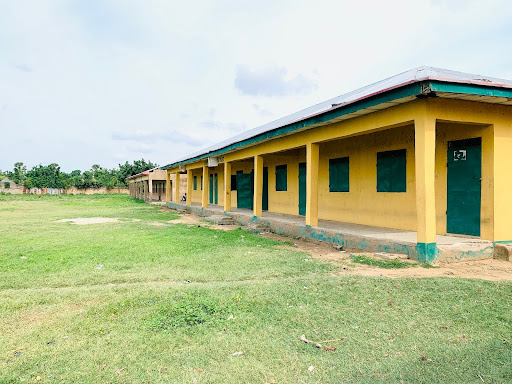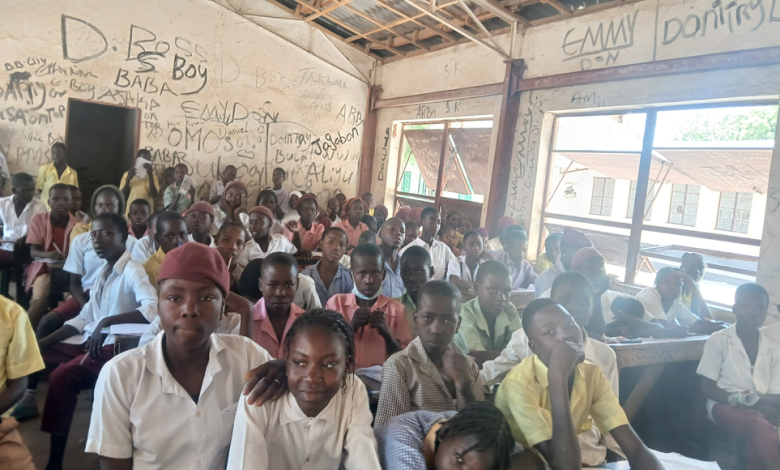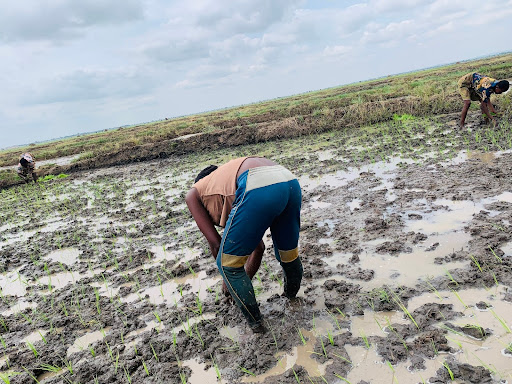In Adamawa State, northeastern Nigeria, a quiet crisis is unfolding. Every week, more children are walking away from school and into the rice fields. For them, it’s not about choice. It’s about survival.
At just 15, Betty should be in school, preparing for exams and dreaming of her future. Instead, she spends her days in muddy rice paddies, bending over under the hot sun, planting seedlings. Like many others, she works long hours for little pay—her education, health, and childhood left behind in the process.
Table of Contents

A Growing Trend in Adamawa: Work Over School
Betty’s story is sadly common. Take Alfred, for example. He’s 18 years old and works as a manager on a rice farm. While his title may sound impressive, his reality is tough. He starts his day before sunrise and finishes late into the evening. For the first three months of his work, he wasn’t paid. When the harvest came, he finally received ₦100,000 and a bag of rice for all that effort.
Alfred remembers working through the harvest without even going home. “We harvested over 100 bags of rice,” he says. “I stayed on the farm for more than three days without bathing.”
For Alfred and many others, the rice season begins in June and ends in September. That means months of physically demanding work, and no time for school.
Child Labour in the Fields
Younger children like Philip also work on farms, though their experience is even harder. He earns around ₦1,000 per day. But that doesn’t go far. He spends ₦500 on food and ₦200 on painkillers for sore muscles, leaving him just ₦300.
Philip sometimes manages to attend school in the morning and go to the farm in the afternoon. But most days, fatigue wins. He says he earns about ₦4,000 a week when work is steady.
Meanwhile, adults working on the same farms earn ₦2,500 to ₦3,500 daily—up to three times what children make. This wage gap shows how unfair and exploitative the system can be.
The Legal Situation
Under Nigeria’s Child Rights Act, it’s illegal for children under 15 to work full time—especially in jobs that affect their health, safety, or schooling. Hazardous work is strictly prohibited.
But enforcement is weak. In rural communities like those in Adamawa, poverty forces families to rely on their children’s income. Laws mean little when hunger is involved.
Why Are Children Leaving School?
There isn’t just one reason. There are many.
First, poverty. Over 75% of people in Adamawa live below the poverty line. Many parents can’t afford school materials or transportation—even when education is technically free.
Second, insecurity. Years of violence from Boko Haram, clashes between farmers and herders, and general instability have destroyed schools and displaced thousands. Some children have never even been inside a classroom.
Third, culture. In the North, many boys are sent to Islamic schools under the Almajiri system. While meant to provide religious education, it often leads to children begging and street labour. For girls, the situation is also difficult. They’re expected to help at home or on the farm, especially during planting and harvest seasons.
Fourth, lack of quality schools. Many schools in Adamawa are understaffed or poorly equipped. According to UNICEF, only 29% of teachers in the region are properly trained. That makes it harder for students to stay motivated and for parents to see the value of sending them to school.

How Bad Is It?
The numbers are serious.
UNICEF reports that nearly 2 million children are out of school in Borno, Adamawa, and Yobe States combined. In Adamawa, about 39% of children between ages of 5 and 14 are involved in child labour. Around 30% of teens aged 5–17 do hazardous work, which is illegal under both Nigerian and international law.
Some Progress—But It’s Not Enough
There have been efforts to turn things around. In 2024, UNICEF and the state government launched a campaign that helped 384,545 children in Adamawa return to school. About half of them were girls.
These efforts included distributing learning materials, training teachers, and creating safe school environments. But many children—especially in rural areas—still remain out of school or drop out again after only a short return.
Alfred says he hopes to return to school someday and study engineering. Betty wants to become a nurse. But they both know that dreams are hard to chase when hunger and hardship stand in the way.
What Can Be Done?
Experts say there are several things that must happen:
- Enforce child labour laws in farms and rural workplaces.
- Help families with food support, transport for students, and small income grants so children don’t have to work.
- Improve school quality by hiring trained teachers and repairing damaged buildings.
- Address conflict and insecurity so families can safely return home and rebuild.
- Work with local leaders to shift cultural expectations and reduce child labour.

Conclusion
Children like Alfred and Betty should be learning in safe classrooms, not struggling to survive in muddy fields. While laws exist to protect them, action must follow. Communities, governments, and international partners must come together to protect the rights and futures of Nigeria’s most vulnerable.
The real cost of child labour isn’t just lost income—it’s lost potential. When a child leaves school for labour, it doesn’t just affect their future. It affects the future of the entire nation.
Join Our Social Media Channels:
WhatsApp: NaijaEyes
Facebook: NaijaEyes
Twitter: NaijaEyes
Instagram: NaijaEyes
TikTok: NaijaEyes
READ THE LATEST EDUCATION NEWS




